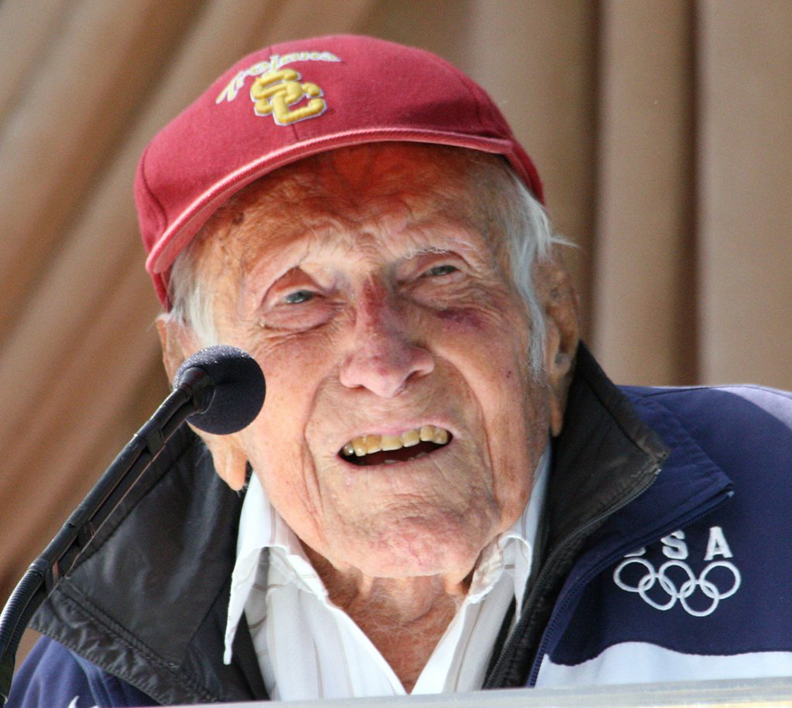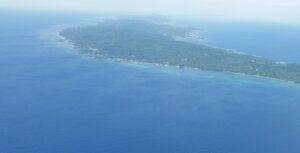Louis Zamperini first gained fame as one of the greatest middle distance runners of all time. He represented the United States in the 5,000m at the 1936 Berlin Olympics.
Then World War II broke out, and his life took a drastic turn. He spent 47 days drifting on a life raft in the Pacific. He battled years of starvation, disease, and torture from sadistic Japanese prison guards. Eventually, after the President had officially declared him dead, he returned home.
Zamperini was born to immigrant Italian parents shortly after World War I. A delinquent child, he fought, committed petty crimes, was smoking by the age of five, and drinking by age eight. Once after a teacher disciplined him, he deflated her car tires. On another occasion, he threw tomatoes at a cop.
Then one day, a couple of charming ladies encouraged him to try athletics. He quickly discovered that he had a natural ability as a runner. He soon channeled his energy into sport and turned from local terror to local hero.
Delinquent to runner
While running for the University of Southern California, he set a national record over the mile — four minutes 21 seconds. After graduation, he switched to the 5,000m distance. He was the youngest athlete ever to make the team at the Berlin Olympics.

Zamperini at USC.
Although he didn’t have a podium finish in Germany, he returned to a promising running career. He planned on chasing the elusive sub-four minute-mile at the 1940 Olympics, 14 years before Roger Bannister actually achieved it.
But Zamperini never had the chance to try. World War II broke out in 1939, and the Olympics were canceled. Instead, he joined the U.S. Army as a lieutenant in 1941. He never ran competitively again.
Zamperini approached his military training with the same energy and discipline as he had in athletics. He was one of just 15 attendees out of thousands invited to a survival lecture. Although he didn’t know it at the time, the techniques he learned that day later saved his life.
He served as a bombardier on a B-24 airplane and flew several missions. On one, Japanese fighters attacked his plane and riddled it with more than 600 bullets.
The B-24s were ahead of their time but they weren’t without issues. In another sortie off Hawaii in 1943, Zamperini and his crew ran into serious trouble.
The plane crash
They were searching for lost crew members and aircraft when their plane suffered mechanical issues. Both engines lost power, and they plummeted into the ocean south of Oahu.

The impact killed 11 of the crew, leaving just Zamperini, pilot Russell Allen Phillips, and tail gunner Francis McNamara as the sole survivors. But their ordeal was just beginning. For Zamperini, it lasted almost two more years.
Amid the burning fuselage, the three men managed to clamber aboard two life rafts. With no means of communicating, they floated aimlessly in the Pacific Ocean, hoping for rescue and to evade capture.
They drank rainwater and ate fish and birds. Once they managed to capture two albatrosses that landed on their raft. They ate one and used the other as bait to catch fish.
They endured constant famine, blistering heat, and were in dread of capture by the enemy.
Enemy bombers attacked them from above and punctured one of their rafts. Everyone managed to transfer onto the second. When sharks brushed up against it, they fended them off with a paddle.
The outcome appeared bleak, but Zamperini had an inner strength. “When I was on that life raft, I was the only one who was prepared,” he said later, referring to the attention he’d paid to survival training.
After 33 days, McNamara died. The two survivors had little choice but to throw him overboard.
Prisoner of war
Eventually, after 47 days at sea, Zamperini and Phillips managed to steer their raft into the Kwajalein Atoll in the Marshall Islands. They finally set foot on land but were far from safe.
The Japanese captured them almost immediately and separated the pair. Zamperini spent his first six weeks on Kwajalein. Then his captors transferred him to mainland Japan. He was confined in three different POW camps and interrogation centres.
Zamperini’s athletic abilities made him an easy target for a sadistic Japanese corporal named Mutsuhiro Watanabe, who took particular joy in torturing him.
Initially, starvation, disease, exposure, and near-daily beatings from guards were the primary issue. But Watanabe quickly upped the ante, which caused nightmares to Zamperini for years to come.
Watanabe beat him with clubs, bats, and fists, threatening to kill him. He forced Zamperini to punch other prisoners until they were nearly unconscious. He once even forced Zamperini to hold a heavy wooden beam above his head, threatening to shoot him if he dropped it.

Mutsuhiro Watanabe, left, the sadistic guard who reveled in torturing Zamperini. Photo: All That’s Interesting
Guards forced the starvation-weakened Zamperini to run foot races against Japanese soldiers. If he dared to win, they beat him.
By this point, he’d been given up for dead back home. The United States War Department assigned Zamperini an “official death date,” and President Roosevelt signed a condolence letter to his family.
Then Japanese officials tried to have him read propaganda messages over Radio Tokyo, denigrating the U.S. government.
In September 1945, more than two years after Zamperini’s plane crashed, Japan surrendered and he was liberated.
“None of us believed [he was alive]. None of us. Never once. Not underneath, even,” Zamperini’s sister Sylvia said.
The long aftermath
Zamperini arrived home famous. He had been an Olympic hero thought to have perished at sea. “After being declared dead and finding that we’d crashed and survived the 47-day drift and nearly 2,000 miles, you get quite a bit of publicity,” he later said.
But the damage he received during his time as a prisoner was irreversible, and the years of malnutrition and torture rendered him unable ever to run competitively again. He was plagued by nightmares. Like many returned servicemen, he used alcohol to stave off the memories. He eventually found solace in Christianity and was able to forgive the men who tortured him.
Zamperini returned to Japan five years after his release, facing his former guards. He shook hands with most, some he embraced. Watanabe was absent, so Zamperini penned a letter to him, forgiving him instead.
Watanabe was later listed as number 23 on a list of Japan’s most wanted war criminals, but he was never executed.
Zamperini’s story has been chronicled in Laura Hillenbrand’s book, Unbroken: A World War II Story of Survival, Resilience, and Redemption. It has been a bestseller since its publication in 2010. In 2014, Angelina Jolie directed a film version, called Unbroken.
Although he died shortly before Jolie’s film hit theaters, Zamperini viewed it from his hospital bed before passing away in 2013 at the age of 97.







